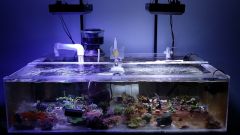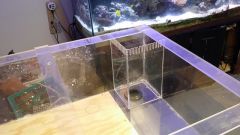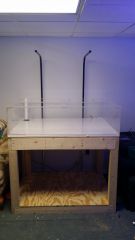-
Posts
874 -
Joined
-
Last visited
About Rob A
- Birthday 02/21/1967
Contact Methods
-
Yahoo
robinmashby@yahoo.com
Custom Fields
-
Gender
Male
-
Location
Stafford, VA
Recent Profile Visitors
1,083 profile views
Rob A's Achievements

Master Reefer (8/13)
-
Hey! Sorry for the delay, I just saw your comment So this would work to deenergize your pump if your sump was too low, but you have to manually reset it if it trips. I am actually using it on a Rollermat filter. In the event that the roll doesn't advance for some reason, and the water level rises, it will shut down my main pump. It has already happened once so it was worth it to set it up. For automatic sump level control I'm using an older model Apex controller with float switches.
-
Elvislewis88 started following Rob A
-
I also have a thieling rollermat. I had the drain line from my 150 gallon tank running to it with a tee fitting allowing excess water to divert into the sump. So ended up with only about half of the water that left the tank actually getting through the filter. This was definitely removing particulate from the tank but again, half the water was still dumping into the sump without any filtration. So then I wasn't sure how effective it was even though it was removing some articulate. I feel like I need either two roller systems combined in order to handle all the water flow or else one big giant roller mat if one existed. If I remember right, one roll of material lasted about 3 months. I don't have it hooked up at the moment I'm not sure what I'm going to do next. Pictures of my rollermat setup are near the end of this posting:
-
I recently purchased one of these things to try and use it as a float switch. Turns out it doesn't work that way. The instructions are lacking so I made my own write up. They are about $59. They also make a skimmer high level safety switch and a heater/high temp safety switch. This device is basically a switched outlet with a “change of state” sensor that works like a circuit breaker and has an alarm, and it has to be reset each time it it's triggered, either by cycling power to it (turning it off and on) or unplugging it and plugging it back in. This device is capable of two different types of operation, either sensing a drop in water level or sensing a rise in water level. It only can do one of those at a time and will not function like a float switch, as in it won’t turn on and off repeatedly as water levels change. It is a one shot/one time switch until you cycle power to it. Once power is applied it goes through a 4 to 5 minute boot up/set up process. During that time it senses what you want it to do based on where you placed the sensor, as described below: Option 1-Low level sensor: Place the sensor below the water level and then plug it in/apply power. The outlet will energize and beep for several seconds while flashing a blue light. It will continue to flash the blue light for 4 to 5 minutes until it is finished setting up, and then it will turn solid blue. At that point it is now monitoring. If the water level drops below the sensor's position, the outlet will “trip” (de-energize) and begin flashing a red light while also making a slow beeping sound. This will continue until you remove power from the device/unplug it. Even if the water level is restored to normal, the device will remain de-energized and in alarm until power is cycled. Option 2- High level sensor: Place the sensor above the water level and then plug it in/apply power. The outlet will energize and beep for several seconds while flashing a blue light. It will continue to flash the blue light for 4 to 5 minutes until it is finished setting up, and then it will turn solid blue. At that point it is now monitoring. If the water level rises above the sensor's position, the outlet will “trip” (de-energize) and begin flashing a red light while also making a slow beeping sound. This will continue until you remove power from the device/unplug it. Even if the water level is restored to normal, the device will remain de-energized and in alarm until power is cycled. Something to watch out for: If the water level changes while the sensor is in the middle of its five minute flashing/setup cycle it will affect the desired setting. This could be an issue after a power outage when water levels may shift while the device is going through its 5 minute start up cycle.
-
Oh, yeah, actually it looks like it is. I hadn't seen the adapter cable in person and just assumed it had a smaller RJ connector. I found a pinout. Now I just have to decide if it's worth saving 20 bucks to DIY it and possibly fry something...
-
I don't know if it's relevant...but I had a 220 for awhile with a handful of decent size tangs and any time I tried to add branching type coral (acro/digi's/stylos/etc) they would break it and/or knock it down. Like I'd glue in a frag and later find it in pieces on the sand bed. I don't know if it was by accident or if they were just jerks. Small flatter stuff (acan/favia/etc) didn't usually didn't get messed with. I have a 150 now (still have a few tangs) but I'm not adding more fish because I'd like to have a higher ratio of coral to fish.
-
Cool. Does anyone know the pinout to make your own 3.5mm to RJ (9 or 12?) adapter for an Apex controller?
-
I'm going to overthink it here...I would run water in through the bottom and out the top to help prevent any air pockets from forming in the lower section due bubbles or micro-bubbles that might happen to flow into it. If an air pocket forms then part of the cooling coil would be out of the water and possibly start freezing. Odd's are probably low that that would be a problem, just something to consider. Large industrial/commercial heat exchangers are designed to have flow in a particular direction for optimal performance but on something this small I doubt there is any performance issue to consider.
-
Rob A started following Frag tank in operation , Overflow and Frag tank and stand
-

Power outage solutions: generator versus solar + battery
Rob A replied to roni's topic in General Discussion
Great advice Dave! Thanks! -

Power outage solutions: generator versus solar + battery
Rob A replied to roni's topic in General Discussion
I've begun investigating the whole house system after the latest 36hr power outage. I wish I could get the deal xabo got! I would schedule that today! The local price of a 16kw generator is twice what he paid and I assume installation will be a lot more too. Last week I found a great chart with the fuel consumption rates but now I can't find it. But here is another one with Generac fuel consumption rates based on 1/2 and full load. Basically about 2.5gph to 3gph respectively when using LP with a 16kw gen. (Middle of the 3rd page): https://cityelectricsupply.com/images/catalogs/2017/04-Apr/generac-home-generators-guardian-9kw-22kw_sell-sheet-2017.pdf Not sure what size I need yet, I just used the 16kw as an example. -
I've always had a high bioload, for the last 9 years and several tank swaps (120, then 220 then 150). I'm thinking about getting rid of my big fish so I can clean up my system and focus on hard corals. I ran a couple different coral only frag system for a couple of years and still had some nitrates and phosphates but they were more easily controlled.
-
That book excerpt seems to suggests that nitrates will just eventually balance out to 0 on their own. Has this ever happened for anyone (with fish) without some proactive measures such as dosing carbon (vodka/sugar/vinegar/nopox), running a denitrifier, algae scrubber, chaeto ball, etc?
-
For a while now there have been those little tiny plastic pellets in some hand soaps that I believe have just recently been outlawed. I assume those things have also been gumming up fish and critters in oceans and rivers? I don't know if the pellets can make it back into the water supply but hopefully an RO unit would filter those out.
-
The little tree thing looks like some sort of clavularia.
-
And thanks! Sent from my SM-N900P using Tapatalk






